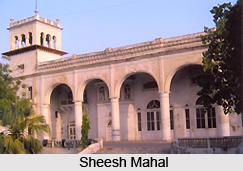 Malerkotla is a city in the Sangrur district of Punjab state in India. It which was the seat of the eponymous princely state during the British Raj agreed to the union of India in the year 1947. It was further merged with the other nearby princely states to create the state Patiala and East Punjab state`s union.
Malerkotla is a city in the Sangrur district of Punjab state in India. It which was the seat of the eponymous princely state during the British Raj agreed to the union of India in the year 1947. It was further merged with the other nearby princely states to create the state Patiala and East Punjab state`s union.
History of Malerkotla
Malerkotla, a Muslim Pathan state in Punjab was founded in 1600. It is quite a known fact that the major genocide that took place during the partition of 1947 that hit Punjab so adversely is a major event in the history of Punjab and did not even touch the city of Malerkotla.
This event`s occurrence can be traced to1705 where in the court the younger sons of the tenth Sikh Guru, Guru Gobind Singh were ordered to be bricked alive by the Governor of Sirhind- Wazir khan. His close relative Sher Mohammad Khan, Nawab of Malerkotla was present in the court when everyone arrived at the conclusion of bricking their sons alive. He vigorously opposed against this order by claiming this punishment as inhuman and brutal and against the principles and code of conduct of Quran and Islam. Guru Gobind Singh saw this man and found his approach to be compassionate, humane and kind. But however at the end Sher Mohammad Khan`s close relatives and Wazir khan assented in midst and both the sons of Guru Gobind Singh were tortured and bricked alive. When Guru Gobind Singh heard this news he pulled out a small plant from the ground and predicted that the Mughal Empire would soon be uprooted and blessed Malerkotla that whatever consequences may happen Malerkotla would not be affected out of any of these problems. This was because of this bless only that the city of Malerkotla did not witness any harm in partition during the year 1947 and remained in peace and harmony.
Visiting places in Malerkotla:
Sheesh Mahal
The Sheesh Mahal is `Palace of Mirrors` cause colorful mirrors has been extensively used in creating the palace. It was built by the Maharaja Narinder Singh in 1845. It looks grand and royal in its marvelous architecture designs. The Sheesh Mahal was constructed in a forest with terraces, gardens, fountains and an artificial lake. The Sheesh Mahal`s finest works includes magnificent collection of antiques, excellent museum, paintings based on literature and mythology, which gives an insight in the times and life of Maharajas of Patiala. Various attractions of Sheesh Mahal include a splendid collection of more than 3000 medals and coins which were brought from allover the world dating back to 12th to the 20th centuries.

Jama masjid
The Jama Masjid is an ancient building of Malerkotla built during the times of princely state. It is very well maintained until today.
Patiala fort
The Qila Mubarak was first built as mud fort or kachi garhi. Then Baba Ali Singh conquered Sirhind and constructed the Pacca Qila. Now the Patiala fort is divided into two folds- Qila Mubarak that is the exterior part and Qila Androon that is the interior part. The darbar hall has now been converted into a mini museum where arms and armours , a sword of Nadir shah has been put into display. The walls have been painted in rajasthani and kangra style which are rare samples of art forms.
Bahadurgarh Fort
This fort is named in the loving memory of honorable Guru Tegh Bahadur. This fort was constructed by Maharaja Karam Singh during 1837-45 at a cost of Rs.10,00,000. Its circumference is one mile, 536 yards and two feet. Saif khan, a relative of Aurangzeb became a solitary person and started staying here. He was an enthusiast of Guru Tegh Bahadur and used to invite him to stay here during the rainy season. After his death he was buried here and his graveyard was located behind the fort. His followers lit a lamp near his graveyard every Thursday. The two inscriptions in the fort are pure evidences of the fact that this place was founded during 1668 during the reign of Aurangzeb.
Moti bagh palace
Moti Bagh Palace is another architectural milestone in the history of India. Moti bagh palace was built by Maharaja Narendra singh in 1847 at a cost of Rs.5 lakhs. Moti Bagh palace was designed on the pattern of Shalimar garden of Lahore. It is a four storeyed structure with huge walls, crowned dome, domed openings. The back portion of the palace has converted into a hilarious park which is liked by all generation be it children or old aged people.



















